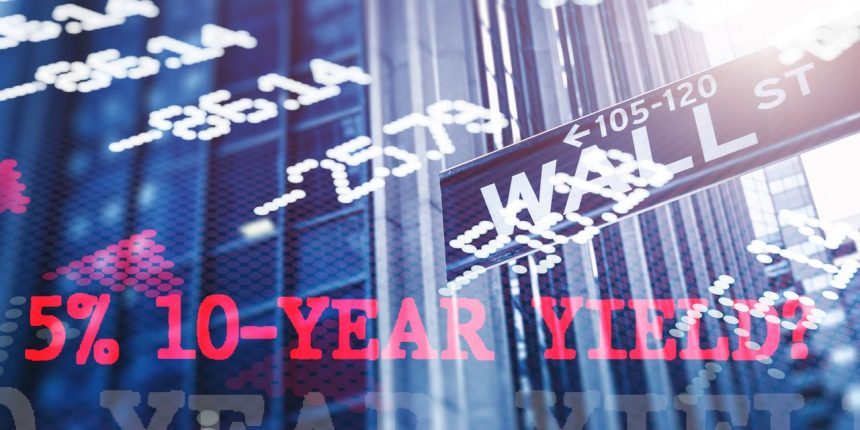There’s been a lot of angst about 1987 of late. In October that year, the market suffered a sharp decline that climaxed with ‘Black Monday’ on the 19th, when the Dow Jones Industrial Average plunged 22.6%. That would be about 7,500 points today.
Nasty. And the reason market observers are getting twitchy is that the crash was preceded by a sharp jump in Treasury yields, just like now. The U.S. number one song 36 years ago was Whitesnake’s Here I go Again. Let’s hope not.
Still, it doesn’t require the stock market to suffer a gut-wrenching dive for portfolios to be hurt. Interest rates staying higher for longer may also do damage. So here’s Saxo Bank’s chief investment officer Steen Jakobsen on what may happen next and what investors should do.
First thing to note is that Jakobsen is in the camp that reckons an important cause of the latest bond yield spike is fiscal in nature, with governments believing they can issue an infinite amount of debt with no consequences for inflation.
“This means we have a market where issuance of bonds (debt) exceeds available capital and hence forces the marginal cost-of-capital up. The market doesn’t believe any government will be willing to go back to a prudent fiscal policy and unfortunately they are right,” says Jakobsen in a new note.
Consequently, we have reached a stage where something is breaking, he says. “The real rates are too high and the global economy is about to tilt down while central bankers are asleep at the wheel.”
But this surging yield environment should impact the thinking of the Federal Reserve. Officials will start talking more about rate cuts in 2024, and the spike at the long end of the yield curve will force the Fed to do some sort of indirect or implicit yield curve control “first through flagging a needed policy shift that keeps the ten to thirty-year yields capped at perhaps 500-525 basis points (5.0%),” he writes.
The Fed may also pause quantitative tightening (halt selling bonds), or stop paying interest on excess reserves from the banking system, which will save the Fed $100-$200 billion a year but will also force banks to buy short-term bonds for their regulatory capital, according to Jakobsen.
That’s what the Fed may do. But what should investors do? Reduce risk, says Jakobsen, and, along with colleague Peter Garnry, he offers five ways to do it.
First, increase cash balances, either by trimming some equity positions, or stop investing more and wait patiently. However: “Investors should generally avoid going all cash as it increases your timing risk – if you got lucky on the way out, you have to be equally lucky getting in again,” says Garnry, Saxo’s head of equity strategy.
Second, hedge your portfolio of long individual stocks by shorting a single index-linked ETF or other instrument where appropriate. “For US-equity exposed portfolios, for example, it might be appropriate to consider the SPDR S&P 500 ETF
SPY,
which is the most traded ETF that tracks the overall S&P 500 index, or the Invesco QQQ Trust Series I ETF
QQQ,
which tracks the Nasdaq 100 index,” says Jakobsen.
Third, rotate into short-term bonds, such as the 2-year Treasury, because real rates are too high for this stage of the economic cycle and they should fall either via inflation falling, yields falling, or both, while the coupon is fixed.
Next, as stagflation risks rise, favor defensives over cyclicals. Historically a stagflation-like scenario is bad for technology, financials and real estate, Garnry reckons. “Defensive sectors such as utilities, energy, consumer staples, and health care typically do much better in a downturn so it is important for investors to avoid being to exposed to cyclical sectors and especially technology stocks,” he adds.
Finally, avoid mega caps. “A big theme this year has been AI which has inflated U,S. mega cap stocks to a degree in which there is now a significant performance difference between an equal-weighted U.S. equity index and a market cap weighted index,” says Garnry.
“This reflects outperformance among these mega caps and that could quickly change if sentiment changes on technology,” he concludes.
Markets
U.S. stock-index futures
ES00,
YM00,
NQ00,
fell and benchmark Treasury yields
BX:TMUBMUSD10Y
jumped after strong jobs data was released. The dollar
DXY
rose, while oil prices
CL.1,
slipped and gold
GC00,
fell.
For more market updates plus actionable trade ideas for stocks, options and crypto, subscribe to MarketDiem by Investor’s Business Daily.
The buzz
All eyes are on the September nonfarm payrolls report, released at 8:30 a.m. Eastern. A net 336,000 jobs were created last month, against forecasts of a 170,000 gain. The unemployment rate remained at 3.8% and hourly wages growth stayed at 0.2%.
Exxon Mobil
XOM,
is close to a deal to buy shale-drilling company Pioneer Natural Resources
PXD,
for about $6o billion, according to reports.
Elon Musk is being sued by the Securities and Exchange Commission to compel him to testify on his deal to buy X, then called Twitter. Meanwhile Tesla shares
TSLA,
are off nearly 4% in premarket trading after the EV maker cut some car prices again.
Shares of Levi Strauss & Co.
LEVI,
are falling more than 2% after the retailer late Thursday cut its outlook for the full year and its executives noted a “continued softness in the wholesale channel, primarily in the U.S.”
Best of the web
Michael Lewis’s big contrarian bet.
Japan is the most exciting market in the world.
‘Ego and identity’: why a courtroom attack on Donald Trump’s wealth touched a nerve.
The chart
It’s 15 years this week since TARP (Troubled Asset Relief Program) finally got passed through Congress at the second attempt, notes Jim Reid, strategist at Deutsche Bank. “Although the financial crisis was in full flow by then, this legislation arguably marked the point where central bank asset purchases became mainstream. G10 balance sheets totaled around $5 trillion at this point, having slowly reached this over centuries of history. By the end of 2021, this figure was close to $30 trillion,” says Reid. And he’s produced the chart below to show how assets have performed in the QE era.
Top tickers
Here were the most active stock-market tickers on MarketWatch as of 6 a.m. Eastern.
| Ticker | Security name |
|
TSLA, |
Tesla |
|
AMC, |
AMC Entertainment |
|
NVDA, |
Nvidia |
|
TTOO, |
T2 Biosystems |
|
GME, |
GameStop |
|
AAPL, |
Apple |
|
NIO, |
NIO |
|
RIVN, |
Rivian Automotive |
|
AMZN, |
Amazon.com |
|
MULN, |
Mullen Automotive |
Random reads
Bonkers for conkers: “Our nuts are in crisis!”
German military top brass removed from White House.
All 73 ‘Saw’ traps ranked for survivability.
Sentences you never thought you’d type: Missing deaf pet skunk found after U.K. garden escape.
Need to Know starts early and is updated until the opening bell, but sign up here to get it delivered once to your email box. The emailed version will be sent out at about 7:30 a.m. Eastern.
Listen to the Best New Ideas in Money podcast with MarketWatch financial columnist James Rogers and economist Stephanie Kelton
Read the full article here




